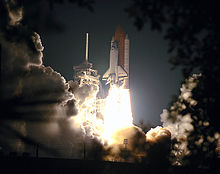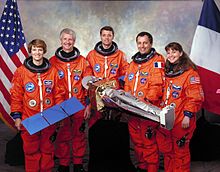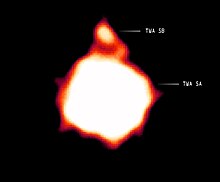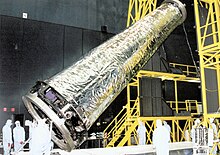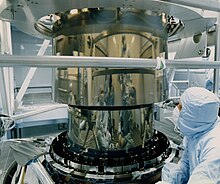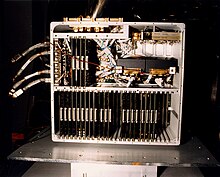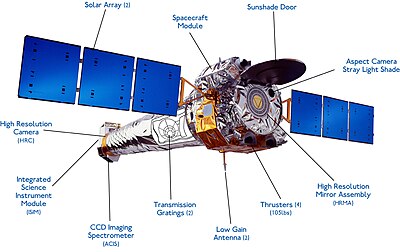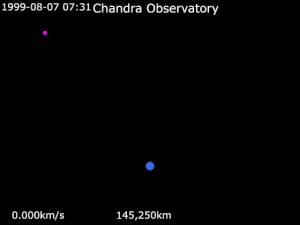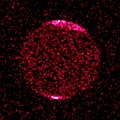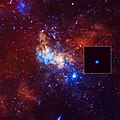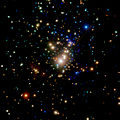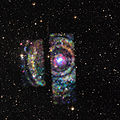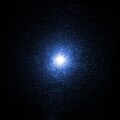
Messier 87 is a supergiant elliptical galaxy in the constellation Virgo that contains several trillion stars. One of the largest and most massive galaxies in the local universe, it has a large population of globular clusters—about 15,000 compared with the 150–200 orbiting the Milky Way—and a jet of energetic plasma that originates at the core and extends at least 1,500 parsecs, traveling at a relativistic speed. It is one of the brightest radio sources in the sky and a popular target for both amateur and professional astronomers.

A supermassive black hole is the largest type of black hole, with its mass being on the order of hundreds of thousands, or millions to billions, of times the mass of the Sun (M☉). Black holes are a class of astronomical objects that have undergone gravitational collapse, leaving behind spheroidal regions of space from which nothing can escape, not even light. Observational evidence indicates that almost every large galaxy has a supermassive black hole at its center. For example, the Milky Way galaxy has a supermassive black hole at its center, corresponding to the radio source Sagittarius A*. Accretion of interstellar gas onto supermassive black holes is the process responsible for powering active galactic nuclei (AGNs) and quasars.

XMM-Newton, also known as the High Throughput X-ray Spectroscopy Mission and the X-ray Multi-Mirror Mission, is an X-ray space observatory launched by the European Space Agency in December 1999 on an Ariane 5 rocket. It is the second cornerstone mission of ESA's Horizon 2000 programme. Named after physicist and astronomer Sir Isaac Newton, the spacecraft is tasked with investigating interstellar X-ray sources, performing narrow- and broad-range spectroscopy, and performing the first simultaneous imaging of objects in both X-ray and optical wavelengths.

The Galactic Center is the rotational center and the barycenter of the Milky Way. Its central massive object is a supermassive black hole of about 4 million solar masses, which is called Sagittarius A*, a compact radio source which is almost exactly at the galactic rotational center. The Galactic Center is approximately 8 kiloparsecs (26,000 ly) away from Earth in the direction of the constellations Sagittarius, Ophiuchus, and Scorpius, where the Milky Way appears brightest, visually close to the Butterfly Cluster (M6) or the star Shaula, south to the Pipe Nebula.

Centaurus A is a galaxy in the constellation of Centaurus. It was discovered in 1826 by Scottish astronomer James Dunlop from his home in Parramatta, in New South Wales, Australia. There is considerable debate in the literature regarding the galaxy's fundamental properties such as its Hubble type and distance. NGC 5128 is one of the closest radio galaxies to Earth, so its active galactic nucleus has been extensively studied by professional astronomers. The galaxy is also the fifth-brightest in the sky, making it an ideal amateur astronomy target. It is only visible from the southern hemisphere and low northern latitudes.

NASA's series of Great Observatories satellites are four large, powerful space-based astronomical telescopes launched between 1990 and 2003. They were built with different technology to examine specific wavelength/energy regions of the electromagnetic spectrum: gamma rays, X-rays, visible and ultraviolet light, and infrared light.

Sagittarius A*, abbreviated Sgr A*, is the supermassive black hole at the Galactic Center of the Milky Way. Viewed from Earth, it is located near the border of the constellations Sagittarius and Scorpius, about 5.6° south of the ecliptic, visually close to the Butterfly Cluster (M6) and Lambda Scorpii.

The Sombrero Galaxy is a peculiar galaxy of unclear classification in the constellation borders of Virgo and Corvus, being about 9.55 megaparsecs from the Milky Way galaxy. It is a member of the Virgo II Groups, a series of galaxies and galaxy clusters strung out from the southern edge of the Virgo Supercluster. It has an isophotal diameter of approximately 29.09 to 32.32 kiloparsecs, making it slightly bigger in size than the Milky Way.

The Center for Astrophysics | Harvard & Smithsonian (CfA), previously known as the Harvard–Smithsonian Center for Astrophysics, is an astrophysics research institute jointly operated by the Harvard College Observatory and Smithsonian Astrophysical Observatory. Founded in 1973 and headquartered in Cambridge, Massachusetts, United States, the CfA leads a broad program of research in astronomy, astrophysics, Earth and space sciences, as well as science education. The CfA either leads or participates in the development and operations of more than fifteen ground- and space-based astronomical research observatories across the electromagnetic spectrum, including the forthcoming Giant Magellan Telescope (GMT) and the Chandra X-ray Observatory, one of NASA's Great Observatories.

Einstein Observatory (HEAO-2) was the first fully imaging X-ray telescope put into space and the second of NASA's three High Energy Astrophysical Observatories. Named HEAO B before launch, the observatory's name was changed to honor Albert Einstein upon its successfully attaining orbit.
Amy J. Barger is an American astronomer and Henrietta Leavitt Professor of Astronomy at the University of Wisconsin–Madison. She is considered a pioneer in combining data from multiple telescopes to monitor multiple wavelengths and in discovering distant galaxies and supermassive black holes, which are outside of the visible spectrum. Barger is an active member of the International Astronomical Union.

APM 08279+5255 is a very distant, broad absorption line quasar located in the constellation Lynx. It is magnified and split into multiple images by the gravitational lensing effect of a foreground galaxy through which its light passes. It appears to be a giant elliptical galaxy with a supermassive black hole and associated accretion disk. It possesses large regions of hot dust and molecular gas, as well as regions with starburst activity.

AstroSat is India's first dedicated multi-wavelength space telescope. It was launched on a PSLV-XL on 28 September 2015. With the success of this satellite, ISRO has proposed launching AstroSat-2 as a successor for AstroSat.
Leon P. Van Speybroeck was an American astronomer who served as Telescope Scientist for the Chandra X-Ray Observatory, which was launched into space aboard the Space Shuttle Columbia in 1999. Van Speybroek designed the mirrors that made possible its spectacular X-ray images of nearby and remote celestial objects, including comets, exploding stars, jets of gas spewing from nearby black holes, and powerful quasars more than 10 billion light years from Earth. The data from Chandra prompted new discoveries about the evolution of stars and galaxies, the nature of the black holes, dark matter, and the shape and dimensions of the universe.

The 215th meeting of the American Astronomical Society (AAS) took place in Washington, D.C., Jan. 3 to Jan. 7, 2010. It is one of the largest astronomy meetings ever to take place as 3,500 astronomers and researchers were expected to attend and give more than 2,200 scientific presentations. The meeting was actually billed as the "largest Astronomy meeting in the universe". An array of discoveries were announced, along with new views of the universe that we inhabit; such as quiet planets like Earth - where life could develop are probably plentiful, even though an abundance of cosmic hurdles exist - such as experienced by our own planet in the past.

The International X-ray Observatory (IXO) is a cancelled X-ray telescope that was to be launched in 2021 as a joint effort by NASA, the European Space Agency (ESA), and the Japan Aerospace Exploration Agency (JAXA). In May 2008, ESA and NASA established a coordination group involving all three agencies, with the intent of exploring a joint mission merging the ongoing XEUS and Constellation-X Observatory (Con-X) projects. This proposed the start of a joint study for IXO. NASA was forced to cancel the observatory due to budget constraints in fiscal year 2012. ESA however decided to reboot the mission on its own developing Advanced Telescope for High Energy Astrophysics as a part of Cosmic Vision program.

The Lynx X-ray Observatory (Lynx) is a NASA-funded Large Mission Concept Study commissioned as part of the National Academy of Sciences 2020 Astronomy and Astrophysics Decadal Survey. The concept study phase is complete as of August 2019, and the Lynx final report has been submitted to the Decadal Survey for prioritization. If launched, Lynx would be the most powerful X-ray astronomy observatory constructed to date, enabling order-of-magnitude advances in capability over the current Chandra X-ray Observatory and XMM-Newton space telescopes.

Imaging X-ray Polarimetry Explorer, commonly known as IXPE or SMEX-14, is a space observatory with three identical telescopes designed to measure the polarization of cosmic X-rays of black holes, neutron stars, and pulsars. The observatory, which was launched on 9 December 2021, is an international collaboration between NASA and the Italian Space Agency (ASI). It is part of NASA's Explorers program, which designs low-cost spacecraft to study heliophysics and astrophysics.

Arcus is a proposed X-ray space observatory proposed to NASA's Explorer program, Medium Explorer (MIDEX) class.

